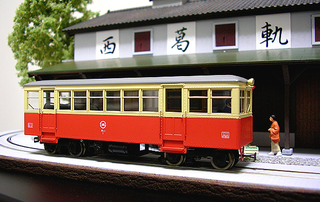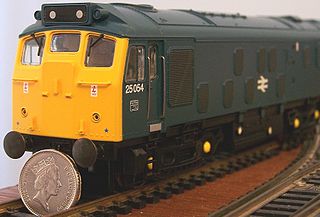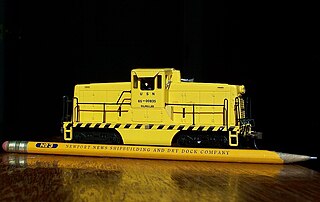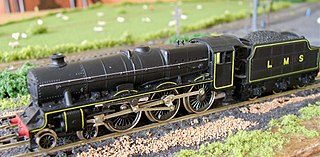
Railway modelling or model railroading is a hobby in which rail transport systems are modelled at a reduced scale.

OO gauge or OO scale is the most popular standard gauge model railway standard in the United Kingdom, outside of which it is virtually unknown. OO gauge is one of several 4 mm-scale standards, and the only one to be marketed by major manufacturers. The OO track gauge of 16.5 mm corresponds to prototypical gauge of 4 ft 1+1⁄2 in, rather than 4 ft 8+1⁄2 in standard gauge. However, since the 1960s, other gauges in the same scale have arisen—18.2 mm (EM) and 18.83 mm (Scalefour)—to reflect the desire of some modellers for greater scale accuracy.

O scale is a scale commonly used for toy trains and rail transport modelling. Introduced by German toy manufacturer Märklin around 1900, by the 1930s three-rail alternating current O gauge was the most common model railroad scale in the United States and remained so until the early 1960s. In Europe, its popularity declined before World War II due to the introduction of smaller scales.

HO or H0 is a rail transport modelling scale using a 1:87 scale. It is the most popular scale of model railway in the world. The rails are spaced 16.5 millimetres (0.650 in) apart for modelling 1,435 mm standard gauge tracks and trains in HO.

N scale is a popular model railway scale. Depending upon the manufacturer, the scale ranges from 1:148 to 1:160. Effectively the scale is 1:159, 9 mm to 1,435 mm, which is the width of standard gauge railway. However the scale may vary to simulate wide or narrow gauge rail. In all cases, the gauge is 9 mm or 0.354 in. The term N gauge refers to the track dimensions, but in the United Kingdom in particular British N gauge refers to a 1:148 scale with 1:160 track gauge modelling. The terms N scale and N gauge are often inaccurately used interchangeably, as scale is defined as ratio or proportion of the model, and gauge only as a distance between rails. The scale 1:148 defines the rail-to-rail gauge equal to 9 mm exactly, so when calculating the rail or track use 1:160 and for engines and car wheel base use 1:148.

2 mm scale, often 2 mm finescale is a specification used for railway modelling, largely for modelling British railway prototypes. It uses a scale of 2 mm on the model to 1 foot on the prototype, which scales out to 1:152. The track gauge used to represent prototype standard gauge is 9.42 mm. Track and wheels are closer to dead scale replicas than commercial British N.

EM gauge is a variant of 4 mm to a foot (1:76) scale used in model railways.
Protofour or P4 is a set of standards for model railways allowing construction of models to a scale of 4 mm to 300 mm (1 ft) (1:76.2), the predominant scale of model railways of the British prototype. For historical reasons almost all manufacturers of British prototype models use 00 gauge. There are several finescale standards which have been developed to enable more accurate models than 00, and P4 is the most accurate in common use.

4 mm scale is the most popular model railway scale used in the United Kingdom. The term refers to the use of 4 millimeters on the model equating to a distance of 1 foot (305 mm) on the prototype (1:76.2). It is also used for military modelling.
HOn30 gauge is the modelling of narrow-gauge railways in HO on N gauge track in 1:87 scale ratio.
ScaleSeven (S7) is a set of finescale model railway standards for 1:43.5 using true-to-prototype track and wheel standards. It is principally used to model British standard gauge, Irish Broad Gauge, or Great Western broad gauge.

O14 is a set of model railway standards for accurately modelling 2 ft narrow-gauge railways in 1:43.5 using 14 mm (0.551 in) gauge track.

Rail transport modelling uses a variety of scales to ensure scale models look correct when placed next to each other. Model railway scales are standardized worldwide by many organizations and hobbyist groups. Some of the scales are recognized globally, while others are less widespread and, in many cases, virtually unknown outside their circle of origin. Scales may be expressed as a numeric ratio or as letters defined in rail transport modelling standards The majority of commercial model railway equipment manufacturers base their offerings on Normen Europäischer Modellbahnen (NEM) or National Model Railroad Association (NMRA) standards in most popular scales.
Proto:87 is a model railroad special interest group founded in 1978, providing a finescale alternative to traditional HO gauge.
3 mm scale, also known as 3 mm finescale, is a model railway scale of 3 mm : 1 ft (305 mm) used for British prototypes. Introduced as British TT gauge, it sits approximately halfway between British N gauge and OO gauge but is not as popular as either and there is no longer any mass manufacturer ready-to-run support. When TT gauge model railways were developed for British prototypes, in order to fit the small British prototypes, the scale was enlarged but without altering the 12mm gauge. The result, British TT gauge, is too narrow. This led to the development of 14.2 mm gauge 3mm finescale. Thus two finescale standards were developed. By far the more common of these is 14.2 mm gauge track, which is accurate. Some modellers choose to use slightly narrower 13.5 mm track due to the necessary oversize motion of outside-cylindered steam locomotives.

British N gauge is a model railway scale and gauge, rolling stock is to a scale of 1:148, track is 9 mm width as with all other N gauges making track and rolling stock approximately 10% out of scale with respect to each other. The 9 mm track width derives from a scale of 1:160 for 1,435 mmstandard gauge rails.
Modelling British railway prototypes is a hobby where railway modelling is applied to British prototypes. For historical reasons, British model scales have developed somewhat separately from those in other countries, and the commercial standards; 00 gauge and British N gauge are unique to British prototypes. The railways in Britain were for the most part standard gauge, and consequently most support focuses on these scales. Narrow gauge, and broad gauge standards also exist. British modellers tend to focus on British subjects, and most of the commercial support is British-based, but modellers of British prototypes exist across national boundaries.
American OO scale is a model railroad standard that has a scale of 4 mm to 1 foot (1:76) and utilises 19 mm for the standard gauge track.









